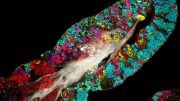
Found in lakes and rivers worldwide, single-celled creatures like these Paramecium bursaria can both eat and photosynthesize. Microbes like this play a double role in climate change, releasing or absorbing carbon dioxide — the heat-trapping greenhouse gas that is the primary driver of warming — depending on whether they rely on an animal-like lifestyle or a plant-like lifestyle. Credit: Daniel J. Wieczynski, Duke University
A new study reveals that rising global temperatures could convert widespread microbial communities worldwide from carbon sinks to carbon emitters, potentially triggering climate change tipping points. These findings were recently published in the British Ecological Society’s journal, Functional Ecology.
- New research finds that under a warming climate, ocean plankton and other single-celled organisms, known as mixotrophic microbes – can switch from being carbon sinks to carbon emitters.
- The research also finds that changes in the behavior of these organisms right before they switch can act as an early warning signal for climate change tipping points.
- However, increases in nutrient levels in the environment, such as nitrogen from agricultural runoff, can mute these warning signals.
Carbon sinks to carbon emitters
Mixotrophic microbes are organisms that can switch between photosynthesizing like plants (absorbing carbon dioxide) and eating like animals (releasing carbon dioxide). They are globally abundant, commonly found in freshwater and marine environments, and estimated to make up the majority of marine plankton.
By developing a computer simulation that modeled how mixotrophic microbes acquire energy in response to warming, researchers at Duke University and the University of California Santa Barbara, have found that under warming conditions, mixotrophic microbes shift from being carbon sinks to carbon emitters.
The findings mean that as temperatures increase, these highly abundant microbial communities could change from having a net cooling effect on the planet to a net warming effect.
Dr Daniel Wieczynski of Duke University and lead author of the study said: “Our findings reveal mixotrophic microbes are much more important players in ecosystem responses to climate change than previously thought. By converting microbial communities to net carbon dioxide sources in response to warming, mixotrophs could further accelerate warming by creating a positive feedback loop between the biosphere and the atmosphere.”
The mixotrophic protist Paramecium bursaria can eat bacteria or use photosynthesis to get energy and carbon. Photosynthesis occurs inside the endosymbiotic Chlorella algae (green spheres) that live inside P bursaria cells. Credit: Daniel Wieczynski
Dr Holly Moeller of University of California Santa Barbara and co-author of the study added: “Because mixotrophs can both capture and emit carbon dioxide, they are like ‘switches’ that could either help reduce climate change or make it worse. These bugs are tiny, but their impacts can really scale up. We need models like this to understand how.”
Dr. Jean-Philippe Gibert of Duke University and another co-author of the study said: “State-of-the-art predictive models of long-term climate change currently only account for microbial action in an extremely reductive, partial, or sometimes plain wrong fashion. Research like this is therefore much needed to improve our broader understanding of the biotic controls on Earth’s atmospheric processes.”
An early warning system
The researchers’ model also revealed that right before mixotrophic microbe communities switch to emitting carbon dioxide, their abundance starts to fluctuate wildly. These changes could be detected in nature by monitoring mixotrophic microbe abundance and offer hope that these microbes could act as early warning signals for climate change tipping points.
Dr. Wieczynski said: “These microbes may act as early indicators of the catastrophic effects of rapid climate change, which is especially important in ecosystems that are currently major carbon sinks like peatlands, where mixotrophs are highly abundant.”
However, the researchers also found these early warning signals can be muted by increases of nutrients like Nitrogen to the environment, typically caused by runoff from agriculture and wastewater treatment facilities.
When higher amounts of such nutrients were included in the simulations, the researchers found that the range of temperatures over which the tell-tale fluctuations occur starts to shrink until eventually the signal disappears and the tipping point arrives with no apparent warning.
“Detecting these warning signs is going to be challenging. Especially if they’re getting more subtle with nutrient pollution.” Said Dr. Moeller. “However, the implications of missing them are huge. We could wind up with ecosystems in a much less desirable state, adding greenhouse gases to the atmosphere instead of removing them.”
In the study, the researchers ran simulations using a 4-degree span of temperatures, from 19 to 23 degrees Celsius. Global temperatures are likely to surge 1.5 degrees Celsius above pre-industrial levels within the next five years, and are on pace to breach 2 to 4 degrees before the end of this century.
The researchers caution that the mathematical modeling used in the study draws on limited empirical evidence to investigate the effects of warming on microbial communities. Dr Wieczynski said: “Although models are powerful tools theoretical results must ultimately be tested empirically. We strongly advocate for further experimental and observational testing of our results.”
Reference: “Mixotrophic microbes create carbon tipping points under warming” by Daniel J. Wieczynski, Holly V. Moeller and Jean P. Gibert, 31 May 2023, Functional Ecology.
DOI: 10.1111/1365-2435.14350
The study was funded by the Simons Foundation, the National Science Foundation, and the U.S. Department of Energy.









“… an early warning signal for climate change tipping points.”
There is no evidence for climate ‘tipping points.’ Even the dinosaur-killing asteroid only temporarily changed the climate. Glaciations make major changes to the surface and ecosystems, but come and go. The apparent hot, dry environment of the end of the Permian was replaced by a more moderate climate. The only thing close to a ‘tipping point’ is when a mountain range, which hosted different temperature regimes and corresponding ecosystems, is reduced to a uniform peneplain near sea level — but then these have frequently been re-animated and new mountain ranges have been created to replace them.
After 4.5 billion years, there have been extreme changes in the global climate, but we have never gotten stuck in any single one. So-called ‘Tipping Points’ are scare words, like ‘ocean acidification, that don’t really exist.
You can’t say it won’t happen just because it hasn’t happened yet. The planet has never seen the rate of increase of greenhouse gases that humans have wrought in a geological eye-blink; and we know there are climatic feedback elements that could cascade and accelerate the acceleration of global warming into a permanent (in human time scales) change in the planet’s equilibrium temperature.
You are correct that over “4.5 billion years, there have been extreme changes in the global climate,” but “we” have never experienced them. The viability of human survival depends on the absence of extreme changes in the global climate; so “we” need to be cognizant of the signs and causes of rapid changes to the climate system. You know, like a shockingly rapid decrease in ocean pH, which actually IS occurring. And the prospect of mixotrophic microbes switching from carbon sinks to carbon emitters, which would be another dangerous feedback element in the ongoing rapid global warming. Time to be scared…
The problem that I have with the article is not that it is wrong, it is that it implies that seeing warning signs of a microbial switch to carbon emitting means that we can then switch more rapidly and get our emissions under control sooner. That is far too late to make the entire plant quickly reduce its carbon output.
Waiting for warning signs may literally be fatal for most of the planet’s inhabitants, if that matters to the folks making these decisions.
Personally, I think humans have already passed a threshold. We continue to annihilate other species, burn rainforest, poison our air etc.